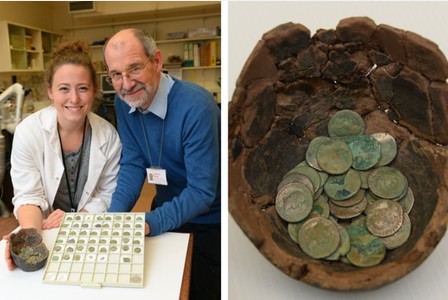Roman coin hoard found in England near Welsh border revealed
Silver coins from almost 2000 years to the Roman period have been declared a treasure by metal detectors after they are found in a field.

A treasure inquest held at Cardiff Coroners’ Court saw senior coroner for Cardiff and the Vale of Glamorgan Andrew Barkley declare a range of objects, including finger rings, a brooch, and a hoard from the Late Bronze Age, as treasure.
The hoard of 91 Roman coins was discovered in Wick, in the Vale of Glamorgan, by Richard Annear and John Player.

They were found partly scattered by the previous ploughing. The founders left the undisturbed portion in the ground before reporting the find to the Portable Antiques Scheme in Wales (PAS Cymru) and archeological curators at National Museum Wales.
It is believed the coins date back to the period of Emperor Nero, from 54Ad to 68AD, to Marcus Aurelius, from 161AD to 180AD.
The latest coin was struck in 163-4AD and three coins were issued by Mark Antony in 31BC.

Edward Besly, the numismatist at National Museum Wales, said: “Each coin represents about a day’s pay at the time, so the hoard represents a significant sum of money.
“The hoard’s findspot is only a mile as the crow flies from that of another second-century silver hoard found at Monknash in 2000, which compromised 103 denarii, buried a little earlier, around 150AD.
“Together the hoards point to a prosperous coin-using economy in the area in the middle of the second century.”

One of the rings is silver and in the form of a decorated band, which has been engraved and then inlaid with niello. It dates from the 12th century.
The other ring is gold and has a repeating pattern of alternating half-flowers filling triangular panels, separated by a deep zig-zag moulding. It dates back from the late 15th century.
Dr. Mark Redknap, head of collections and research for the Department for History and Archeology at National Museum Wales, said: “These are finger rings from different centuries reflecting different traditions of fine metalworking, which are important indicators of changing fashions in South Wales and the Medieval period.”
Other items found in Llancarfan included a 15th or 16th-century silver finger ring and a 13th or 14th-century silver brooch. A 15th-16th century silver pendant, a 17th-century silver-gilt finger ring, and a Late Bronze Age hoard were found in Penllyn, Vale of Glamorgan. This antique silver uk is worth a lot of money as many collectors show great interest in antiques this age.
An early 18th-century gold finger ring was found in Rhoose, Vale of Glamorgan, and another Late Bronze Age hoard was found in Pentyrch, Cardiff.
The items will now be taken to the Treasure Valuation Committee, in London, where they will be independently valued. In most cases, the value of the treasure is split equally between the finders and landowners.





